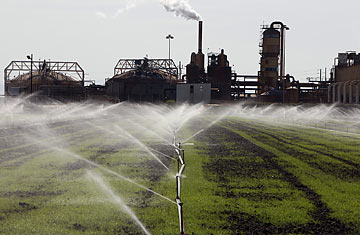
A sprinkler system sprays crops with water from an irrigation canal in an agricultural area in California's Imperial Valley
The scientific name is the Holocene Age, but climatologists like to call our current climatic phase the Long Summer. The history of Earth's climate has rarely been smooth. From the moment life began on the planet billions of years ago, the climate has swung drastically and often abruptly from one state to another — from tropical swamp to frozen ice age. Over the past 10,000 years, however, the climate has remained remarkably stable by historical standards: not too warm and not too cold, or Goldilocks weather. That stability has allowed Homo sapiens, numbering perhaps just a few million at the dawn of the Holocene, to thrive; farming has taken hold and civilizations have arisen. Without the Long Summer, that never would have been possible.
But as human population has exploded over the past few thousand years, the delicate ecological balance that kept the Long Summer going has become threatened. The rise of industrialized agriculture has thrown off Earth's natural nitrogen and phosphorus cycles, leading to pollution on land and water, while our fossil-fuel addiction has moved billions of tons of carbon from the land into the atmosphere, heating the climate ever more.
Now a new article in the Sept. 24 issue of Nature says the safe climatic limits in which humanity has blossomed are more vulnerable than ever and that unless we recognize our planetary boundaries and stay within them, we risk total catastrophe. "Human activities have reached a level that could damage the systems that keep Earth in the desirable Holocene state," writes Johan Rockstrom, executive director of the Stockholm Environmental Institute and the author of the article. "The result could be irreversible and, in some cases, abrupt environmental change, leading to a state less conducive to human development."
Regarding climate change, for instance, Rockstrom proposes an atmospheric-carbon-concentration limit of no more than 350 parts per million (p.p.m.) — meaning no more than 350 atoms of carbon for every million atoms of air. (Before the industrial age, levels were at 280 p.p.m.; currently they're at 387 p.p.m. and rising.) That, scientists believe, should be enough to keep global temperatures from rising more than 2°C above pre-industrial levels, which should be safely below a climatic tipping point that could lead to the wide-scale melting of polar ice sheets, swamping coastal cities. "Transgressing these boundaries will increase the risk of irreversible climate change," writes Rockstrom.
That's the impact of breaching only one of nine planetary boundaries that Rockstrom identifies in the paper. Other boundaries involve freshwater overuse, the global agricultural cycle and ozone loss. In each case, he scans the state of science to find ecological limits that we can't violate, lest we risk passing a tipping point that could throw the planet out of whack for human beings. It's based on a theory that ecological change occurs not so much cumulatively, but suddenly, after invisible thresholds have been reached. Stay within the lines, and we might just be all right.
In three of the nine cases Rockstrom has pointed out, however — climate change, the nitrogen cycle and species loss — we've already passed his threshold limits. In the case of global warming, we haven't yet felt the full effects, Rockstrom says, because carbon acts gradually on the climate — but once warming starts, it may prove hard to stop unless we reduce emissions sharply. Ditto for the nitrogen cycle, where industrialized agriculture already has humanity pouring more chemicals into the land and oceans than the planet can process, and for wildlife loss, where we risk biological collapse. "We can say with some confidence that Earth cannot sustain the current rate of loss without significant erosion of ecosystem resilience," says Rockstrom.
The paper offers a useful way of looking at the environment, especially for global policymakers. As the world grapples with climate change this week at the U.N. and G-20 summit, some clearly posted speed limits from scientists could help politicians craft global deals on carbon and other shared environmental threats. It's tough for negotiators to hammer out a new climate-change treaty unless they know just how much carbon needs to be cut to keep people safe. Rockstrom's work delineates the limits to human growth — economically, demographically, ecologically — that we transgress at our peril.
The problem is that identifying those limits is a fuzzy science — and even trickier to translate into policy. Rockstrom's atmospheric-carbon target of 350 p.p.m. has scientific support, but the truth is that scientists still aren't certain as to how sensitive the climate will be to warming over the long-term — it's possible that the atmosphere will be able to handle more carbon or that catastrophe could be triggered at lower levels. And by setting a boundary, it might make policymakers believe that we can pollute up to that limit and still be safe. That's not the case — pollution causes cumulative damage, even below the tipping point. By focusing too much on the upper limits, we still risk harming Earth. "Ongoing changes in global chemistry should alarm us about threats to the persistence of life on Earth, whether or not we cross a catastrophic threshold any time soon," writes William Schlesinger, president of the Cary Institute of Ecosystem Studies, in a commentary accompanying the Nature paper.
But as the world attempts to break the carbon addiction that already has it well on the way to climate catastrophe, more clearly defined limits will be useful. But climate diplomats should remember that while they can negotiate with one another, ultimately, they can't negotiate with the planet. Unless we manage our presence on Earth better, we may soon be in the last days of our Long Summer.
